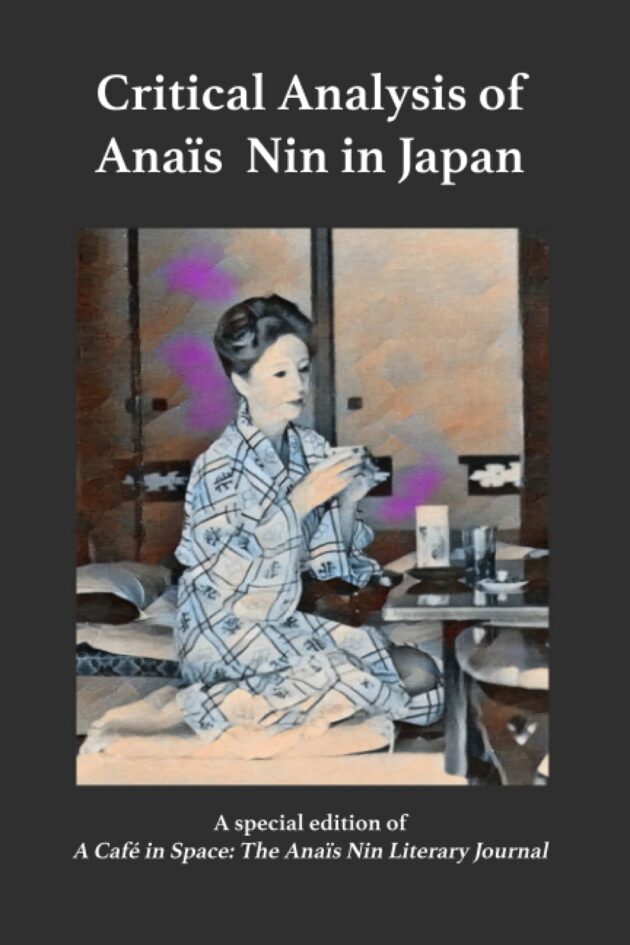

Critical Analysis of Anaïs Nin in Japan, edited by Paul Herron. State College, PA: Sky Blue Press, 2023, 216pgs. ¥2,998 (paper).
“In Japan,” the French-born American novelist and diarist Anaïs Nin writes in her Diary in the summer of 1966, “I had a weeping fit. The sweetness, kindness, consideration touched me. For once in my life I felt I was treated as I always treated people.” These words lead Yuko Yaguchi to conclude of Nin in her introduction to Critical Analysis of Anaïs Nin in Japan that the country “captured her heart.” Nin was in Japan for the launch of her novel, A Spy in the House of Love. Her interest in Japan ran deep: even before travelling there, She was “steeped in Japanese novels, in Lady Murasaki’s work, in Japanese films,” her Diary records. Clearly, she was keen on Japan. But was the feeling mutual?
In the first of seventeen chapters by different authors on Nin in Japan, Catherine Vreeland suggests not. She claims that this is because the “search for a personal and sexual identity is relatively alien to the Japanese female writer” and because modern Japanese women apparently do not write diaries. “To write out of the self and at the same time to write in search of the self,” Vreeland continues, “is a concept foreign to the Japanese.” These are sweeping generalisations. They assume an unchanging Japanese essence that is eternally “alien” to the “West.” Avoiding them is fundamental when thinking about cultures, whose complexities, contradictions, and constant change always elude such simplifications.
Luckily, several chapters in this very book appear to counter Vreeland’s view. Yaguchi’s chapter focuses on the work of the novelist Masako Meio, who translated Nin’s first volume of diaries in 1974 and was married to the literary theorist Kojin Karatani. In Meio’s A Glimpse of a Woman, Yaguchi writes, its main protagonist Yukiko “always dreams of another self she could have lived” and is “driven by a double-edged fear of, and desire for, multiple identity.” In her own chapter, Meio adds that she admires Nin’s “tenacity of self-analysis, her strength in pursuing her independent self.” A male reviewer of her novel even criticised what he saw as the impertinence of “a woman talking about the self.”
Another translator of Nin’s work, Kazuko Sugisaki, observes that “times are changing” and that “we have women writers who write with braver, bolder and more direct strokes.” She describes Takako Takahashi, author among others of the recently translated novel, Waste Land, as “having Nin-like qualities.” In addition to passages from Waste Land, she quotes the following from a Takahashi essay to support her comparison:
What interests me most of all is me, myself . . . Ever since I can remember, I have been concerned with myself, watching and observing my unhappy self.
Meio’s and Takahashi’s oeuvres show that there are, after all, Japanese women writers writing out of the self, in search of the self and a personal and sexual identity. In Meio’s case, this was partly due to her reading and translating Nin’s work.
Despite this evidence of Nin’s influence, a tone of disappointment about her more general reception in Japan pervades the book. Meio recalls that her translation of the first volume of Nin’s Diary “sold less than 6,000 copies in five years and went out of print,” which she believes was because “the majority of Japanese women were content with the historically endorsed definition of femininity, the silent Great Mother.” It’s also worth pointing out, though, that Meio wrote her chapter in 1992. Since then, much has changed, with more attention paid to the voices of women writers in Japan and abroad. Perhaps now, more than ever before, the time is ripe for Japan to fully reciprocate Nin’s affection.
